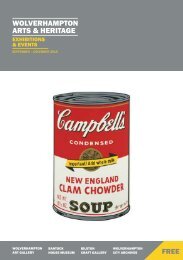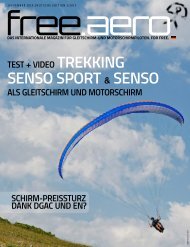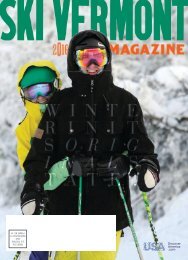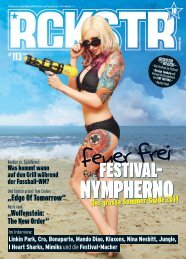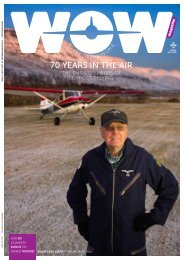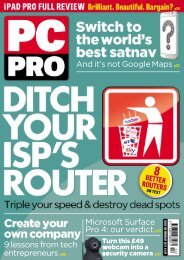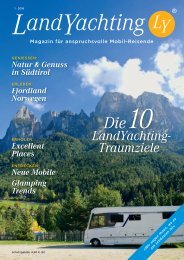Create successful ePaper yourself
Turn your PDF publications into a flip-book with our unique Google optimized e-Paper software.
of the large space telescope. Two primary<br />
contractors built Hubble. Lockheed<br />
Missiles and Space Company of Sunnyvale,<br />
California, produced the protective<br />
outer shroud and the spacecraft systems,<br />
and Perkin-Elmer Corp. in Danbury,<br />
Connecticut, developed the optical system<br />
and guidance sensors. Lockheed also<br />
assembled and tested the finished product.<br />
Hubble’s journey to space began when<br />
it arrived at Kennedy in October 1989 on<br />
a U.S. Air Force C-5A transport jet from<br />
the Lockheed Martin facility in California.<br />
Hubble was transported to the Vertical<br />
Processing Facility (VPF), where prelaunch<br />
preparations were performed. The Payload<br />
Hazardous Servicing Facility also was used<br />
for offline processing of Hubble science<br />
instruments.<br />
“You couldn’t ask for a more customerfriendly<br />
center than Kennedy,” Cepollina<br />
said. “We had, on average, 200 to 300 people<br />
at the center through processing and launch,<br />
including Kennedy, Goddard, Marshall, and<br />
support contractors.”<br />
Bob Webster, NASA payload manager at<br />
the time, noted that Hubble arrived in a very<br />
unique shipping container built by the U.S.<br />
Air Force for military surveillance satellites.<br />
Hubble was transported to the pad using<br />
Kennedy’s payload canister.<br />
Webster recalled several very unusual<br />
events that occurred during processing.<br />
The VPF was operated as a class 100k<br />
clean work area (less than 100,000 particles<br />
larger than 0.5 micrometers in size).<br />
The requirement for Hubble’s sensitive<br />
instruments and lens was less than 20k. The<br />
payload processing team worked diligently<br />
to maintain the VPF at cleanliness levels<br />
between 2k and 5k. The Hubble Space<br />
Telescope Program brought with it an<br />
array of ground support equipment to test<br />
the telescope. Webster said two science<br />
instruments were installed in the telescope in<br />
the VPF.<br />
“Normally, vertical payloads were<br />
transported to the pad before the shuttle,”<br />
Webster said. “We took Hubble to the pad<br />
late in the flow to minimize its time at the<br />
pad.”<br />
The hypergolic fuel was loaded into<br />
Discovery and then Hubble was delivered to<br />
the pad and prepared for installation in the<br />
payload bay using the payload changeout<br />
room (PCR). But, hundreds of midges, a<br />
kind of small fly, had hatched and settled<br />
on the payload bay doors, resulting in an<br />
unknown number of them getting into the<br />
PCR.<br />
Webster said the PCR doors were quickly<br />
closed and an environmental team was called<br />
in to devise a system to remove the flies.<br />
Several lighted traps with small vacuum<br />
devices and dry ice were placed throughout<br />
the clean room to collect the tiny insects, a<br />
process that took about two days.<br />
When the PCR was clear, the eight-hour<br />
process began to install and secure the nearly<br />
44-foot-long Hubble in the shuttle payload<br />
bay for its trip to space. Precise measurements<br />
of the bay and the telescope had been taken<br />
in advance to ensure the clearances.<br />
On launch day April 10, pilot Charlie<br />
Bolden, now the NASA Administrator,<br />
flipped the switches on the shuttle’s auxiliary<br />
power units (APU) and the launch team<br />
realized something was wrong. The flight was<br />
delayed two weeks while the faulty APU was<br />
changed out.<br />
In a process that had never been planned<br />
for, the payload team removed Hubble’s<br />
batteries inside the payload bay and took<br />
them to the Space Shuttle Main Engine<br />
Facility in the Vehicle Assembly Building to<br />
keep them charged. A few days before launch,<br />
the batteries were reinstalled.<br />
“Finally seeing it launch and then<br />
deployed was an exciting experience for the<br />
entire payload processing team,” Webster<br />
said. “I enjoyed working with the people on<br />
the Hubble team. I felt very proud and lucky<br />
to have this opportunity.”<br />
Before retiring from NASA in 2000,<br />
Webster worked as a division chief in the<br />
Space Station Processing Facility, planning for<br />
International Space Station segment arrival<br />
and processing.<br />
Hubble was serviced the first time in 1993<br />
to correct a blurred lens, and four more times<br />
to upgrade or replace several of the telescope’s<br />
sensitive instruments. Each servicing mission<br />
increased Hubble’s ability to reach further<br />
and further back in time and improved the<br />
clarity of the images. Each time, the space<br />
shuttle would bring back Hubble parts and<br />
equipment to be refurbished and reused.<br />
“That first servicing mission produced<br />
the picture that everybody’s seen, called the<br />
Eagle Nebula,” Cepollina said. “The mission<br />
essentially was written around re-establishing<br />
the dream.”



